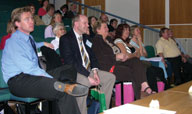 The conference was run by the Children’s Sub Group of the Vision 2020 steering group.
The conference was run by the Children’s Sub Group of the Vision 2020 steering group.
The aim of the conference was to improve services for children with low vision, by encouraging integration across professional groups and sharing good practice. It provided a chance for optometrists to interact with professionals from different disciplines and reflect on current issues affecting children’s low vision services.
Improving Service
Professor David Taylor, Professor of Paediatric Ophthalmology, Institute of Child Health, London, provided an insight into key issues in health today.
He highlighted visual pathway damage as being the major cause of visual impairment in children and recommended that research money be focused in this area. He discussed the importance of an accurate refraction in all cases and the importance of a diagnosis. It is vital that each child is treated according to their needs, not just by the syndrome that they have.
Mike Brace, chief executive of Vision 2020 UK, gave a thought-provoking lecture on social care issues. He provided examples from his personal experience, having been blinded by a firework accident at age 10. Low vision professionals should strive for social inclusion and integration of visually impaired children into society. It is important that they are taught the skills necessary to lead independent lives.
Julie Sweeting, of the SEN Advisory and Teaching Service, Oldham, explained how mainstream schools, supported by Visual Impairment Services, are well placed to meet the needs of learners with low vision. Adapted teaching styles and provision of modified curriculum material such as large print worksheets, maximise learning opportunities for children with low vision. Additional interventions should be based on identified need. Effective and inclusive schools consider the needs of learners with visual impairment in whole school bids and initiatives.
Mary Bairstow, implementation officer, provided an overview of low vision services for children in the UK. Fragmentation of services, inadequate communication and lack of multi-disciplinary working were some of the issues discussed in the Fragmented Vision report. There are still a limited number of ‘integrated’ teams. There is a need for structured multi-disciplinary low vision services, based on children’s habilitative needs.
Practical Steps
Dr Margaret Woodhouse, Cardiff University, hosted an interactive session entitled ‘Blurred Edges – Refraction Explained’. This session was aimed at non-optometrists. There was plenty of audience interaction, delegates being provided with lenses that simulated the effects of myopia, hypermetropia and astigmatism.
Professor Christine Dickinson, University of Manchester, presented a workshop on the assessment of children’s vision. Clinical assessment of vision (using the appropriate age specific test) is about measuring impairment. Functional assessment, however, is about determining activity limitations in the real environment. Functional assessment is beneficial for offering advice to teachers and parents.
Janet (mother) and Rebecca Sharp (child with visual impairment), provided an insight into challenges faced by parents of visually impaired children, and by the children themselves. The value of sympathetic support, a positive attitude and a sense of humour should not be underestimated. The parent and child need to liaise effectively with the child’s school, regarding teaching methods and exam concessions. Rebecca and Janet talked about sibling interactions in the home environment and the importance of promoting independence.
Dr Fiona Fylan, University of York, discussed psycho-social development in children using Piaget’s stages and Erikson’s stages as models for development. Delegates were given a chance to reflect upon how visual impairment affects these normal development processes.
Case by Case
Jenny Gray, Children’s Low Vision Advocate, described the Welsh Low Vision Project for Children. The scheme is funded by the Welsh Assembly Government and run by RNIB Cymru. It aims to improve access to low vision services for children by encouraging multi-disciplinary working and providing an open referral system, leaflets for parents, a contact directory and a website. In conjunction with the Welsh Low Vision Scheme, the project has provided children with services closer to home, shorter waiting times and automatic referral to other services.
Rasmeet Chadha, deputy head of Optometry at Oxford Eye Hospital, presented a case study, ‘The baby with low vision’, illustrating the importance of an active multi-disciplinary low vision service when a number of agencies are involved in providing care. She discussed some current obstacles to providing seamless care, including segregated patient notes and the absence of a clear ‘key worker’. Communication plays a fundamental role in overcoming these obstacles, and is the key to providing efficient care.
Mary Guest, of Sense, presented the final case study, ‘A Child with CHARGE syndrome’. CHARGE is a rare condition that affects various parts of the body, usually the eyes, ears, nose and heart. The condition and its severity vary. Children often have difficulties with communication due to combined vision and hearing problems. A specialist ‘sensory’ curriculum is required so that each child has the opportunity to develop their most appropriate method of communication.
References
1 Ryan, B. and Culham, L. (1999) Fragmented Vision: Survey of Low Vision Services in the UK. RNIB, Peterborough.
Joanne Walls is an optometrist at Oxford Eye Hospital
